
|
Vol 80 |
Page 9 |
Privacy Policy | Editorial Policy | Profit Policy | Join the Association | List of Members | Contact us | Index | Links
Back Go to page: 1 2 3 4 5 6 7 8 9 10 11 12 13 14 15 16 17 18 19 20 Forward

Allan George's Gems.
Contents:
Concession Cards - the differences.
Dickson - the first airport in ATC.
Service Stations - big changes coming.
Wedgetail - now being used by the USAF.
Why you should use Bionic Reading in Chrome (or any browser)
We’re all constantly absorbing information online. Bionic reading is an approach to reading that can help you read faster, retain more information and boost your productivity in your favourite web browsers—like Chrome.
What Is Bionic Reading?

Bionic reading is a method of reading that combines traditional reading with technology-assisted tools. This helps readers increase their reading speed, improve their comprehension and retention and ultimately become more productive in their reading activities.
Was the above paragraph easier and quicker to read? If you said yes, then you’ve just experienced some of the benefits of bionic reading. Now, imagine that for a whole article, essay, or book.
Your brain doesn’t always read every letter of every word. It only intakes enough information for you to understand a word and then it moves on to the next one. The bolding of the first half of each word lets your mind fast-track through paragraphs. The bolding aspect is the most notable factor in bionic reading, but there’s more as well. A lot of apps and extensions also remove colours from images and change white or black backgrounds to grey. These changes help your eyes focus on the text.
Why you should use Bionic Reading in Chrome (or your preferred browser)
Using Bionic Reading in Chrome, or any other web browser, can offer several benefits.
-
It can help you read faster and more efficiently, which allows you to cover more material in less time.
-
It can also help you retain more information by training your brain to focus on the most important parts of any text.
As a result of the two above-mentioned benefits, it can improve your productivity by allowing you to process information more effectively. This can be particularly useful in academic or work-related settings. Bionic reading in any browser can be a valuable tool for anyone looking to optimize their online reading experience.
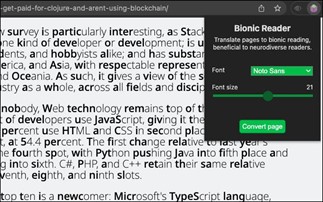
How Bionic Reading Helps You Read Faster and More Efficiently.
Bionic reading helps you read faster and more efficiently with techniques including skimming, scanning, chunking and altering images to be easier on the eye. For example, when you skim a text, you quickly glance through it to get a general idea of the content without reading every word. Similarly, when you scan a text, you search for specific keywords or phrases that are relevant to your reading goals.
By using these techniques, you can save time and energy. Bionic reading tools like web browser extensions or apps can help automate some of these techniques.
How Bionic Reading trains your brain to retain information.
By using bionic reading, you can begin to retain more information by training your brain to focus on the most crucial parts of any text, such as key concepts, arguments, or evidence. Through using techniques like skimming or scanning, you can quickly identify the main points of the text and decide what information is relevant to your reading goals. In turn, this uses less mental energy. By consistently applying these techniques, you can train your brain to become more efficient at processing and retaining information. Studying, researching and editing your own work can become easier as a result.
How Bionic Reading can improve your productivity
Before we go into how bionic reading increases your productivity, you need a frame of reference for how your productivity can suffer through everyday means. Using your eyes takes up about 50% of your brain power. That’s more than any of your other senses. We, as humans, heavily rely on our vision for pretty much everything we do.
Right now, you’re likely reading this with your eyes, but, at any moment, you’ll look away to find your drink so that you can grab it and take a sip, or, you’ll check your phone, your watch, or a nearby clock—and any number of other visual tasks on top of that. Reading faster and more efficiently drastically cuts down on the stress your eyes and brain suffer while researching, writing and doing similar work—especially when you’re mentally digesting new information.
As your brain becomes able to retain more information, you’ll need to re-read the same text less often.
To summarize, by improving your reading efficiency and training your brain to better retain information, your productivity may increase.
How to use the Bionic Reading Extension in Chrome
You can get the Bionic Reading extension for Chrome on the Chrome Web Store. After installing it, you can manage the Bionic Reading extension through the Extensions menu at the top-right of your window (click the little jigsaw piece icon).
You’re now ready to begin using the Bionic Reading extension! When you want to activate it on any given webpage, all you need to do is click the jigsaw piece icon at the top-right of your window and then click the Bionic Reading extension. To turn Bionic Reading off, do the same thing again.
That’s all there is to it! Start saving your energy for tougher tasks by letting Bionic Reading do the heavy visual lifting.

The differences between concession cards.

On the face of it, the Pensioner Concession Card and the Commonwealth Seniors Health Card both look very much the same, but there are some vital differences between the cards relating to eligibility and discounts.
Pensioner Concession Card.
The Pensioner Concession Card (PCC) is available to people who receive certain Centrelink payments. Those payments are the Age Pension, Carer Payment, Disability Support Pension, JobSeeker or Youth Allowance and the Parenting Payment. You do not need to apply for a Pensioner Concession Card. Centrelink will send you one if you’re eligible.
The benefits of the PCC include:
-
cheaper medicine under the Pharmaceutical Benefits Scheme
-
bulk-billed doctor visits (depending on your doctor)
-
a bigger refund for medical costs when you reach the Medicare Safety Net
-
help with hearing services, such as the Hearing Services Program on the Department of Health and Aged Care website
-
discounts to redirect your mail through Australia Post.
If you have any dependent children, they may also be eligible for some of these benefits. You may also be eligible if you have a partial capacity to work and receive JobSeeker or a Parenting Payment.
Your state or territory government or local council may also offer more benefits including discounts on utility bills, water and rates, discounted public transport and vehicle registrations.
Here is a state-by-state and territory guide to discounts and concessions:
-
Victorians can check here.
-
NSW can check here
-
Queensland can check here
-
Northern Territory here
-
Western Australia here.
-
South Australia here.
-
ACT here
-
Tasmania here.
You will not need to renew your card. Centrelink will send a new card four to six weeks before the expiry date on your current card. The card is valid for two years. You can find the instructions to download a digital version to your phone here. While you will automatically receive a card if you are eligible, you will have to let Centrelink know about changes in circumstances if you hold a card, including if you:
-
change or correct your name
-
you marry or start or stop living with your partner
-
you start or stop being the main carer of a child
-
your home address changes
-
your or your partner’s income or assets change
-
you don’t have to lodge a tax return
-
your work or study load changes
-
you are leaving Australia.
You will need to inform Centrelink of any changes within 14 days by visiting an office or using your online Centrelink account or MyGov account. If you receive payments you are not eligible for through the card, because your circumstances have changed, you may have to pay the money back plus a fee.
Commonwealth Seniors Health Card
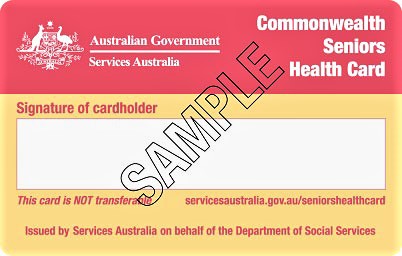
The Commonwealth Seniors Health Card allows you to receive cheaper healthcare and some discounts if you have reached Age Pension age. You may be eligible if you are:
-
Age Pension age or older
-
meet residence rules
-
not getting an income support payment from Centrelink or the Department of Veterans’ Affairs
-
meet identity requirements
-
meet the income test.
When you apply for the card, you must supply your tax file number and that of your partner, unless you are exempt.
You can begin the application process here.
You may need to provide your identity, including a Centrelink Customer Reference Number. If you have a partner, they will also have to prove their identity if you are claiming a Low Income Health Care Card or Farm Household Allowance.
Health Care Card.
A Health Care Card will give you access to cheaper medicines and some discounts if you receive the following payments from Centrelink:
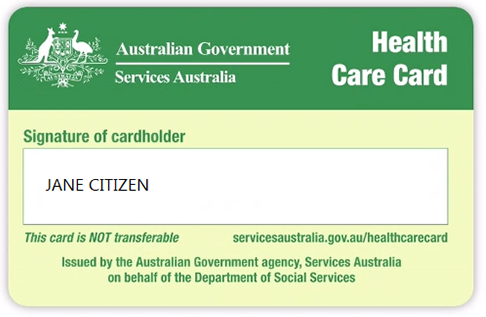
-
Parenting Payment partnered
You can also get a card for up to one year if you get any of the following payments:
-
Carer Allowance for a child younger than 16 – the card is for the child in your care only
-
Carer Payment for short term or irregular care less than 6 months
-
the maximum rate of Family Tax Benefit Part A
-
Mobility Allowance if you’re not getting Disability Support Pension.
You must also live in Australia and meet residency rules. Benefits could include:
-
bulk billing for doctor’s appointments, as decided by your doctor
-
more refunds for medical expenses through the Medicare Safety Net
-
discounted mail redirection through Australia Post.
State and territory governments and local councils may also offer concessions for costs such as:
-
energy and electricity
-
healthcare, including ambulance, dental and eye care
-
public transport
-
rates.
Check with the above links mentioned in the Pensioner Concession Card section to see what discounts are available.
|
I showed my wife a photo of the fish Sam caught. Now I’m not allowed to go fishing with Sam anymore! |
 |
Dickson was Canberra's first airport (and the site of a fatal plane crash.)
Dickson in the ACT might be an average looking urban landscape today, home to a shopping centre, library and wetlands area but go back to the early 20th century and it was home to the national capital’s first airport. A simple plaque by the front door of the Dickson Library commemorates the ‘Dickson Aerodrome’, which opened on the 4th March, 1924.
Canberra’s architect Walter Burley Griffin first pencilled in the sheep paddock between today’s Majura Avenue and Antill Street for use as an airfield. Following pressure from the Defence Force, the Commonwealth Government revisited the plans in the early 1920s. The first plane landed in 1923, bearing government officials tasked with settling on a site. Air Force pilots went on to use the aerodrome for photography surveys of the area in their flimsy WWI-era biplanes, until 1926 when air operations moved to the current site of the Canberra Airport in the Majura Valley.
On the 26th February of that year, it also became the site of the region’s first air fatality. A graduate of the Duntroon Military College, Philip Mackenzie Pitt and his photographer William Callander were coming in for a landing after a survey of the Murrumbidgee River. Observers later recalled the engine appeared to be running normally, but at 100 feet above ground, the DH9 plane suddenly stalled, spun and nose-dived into the ground where it burst into flames.
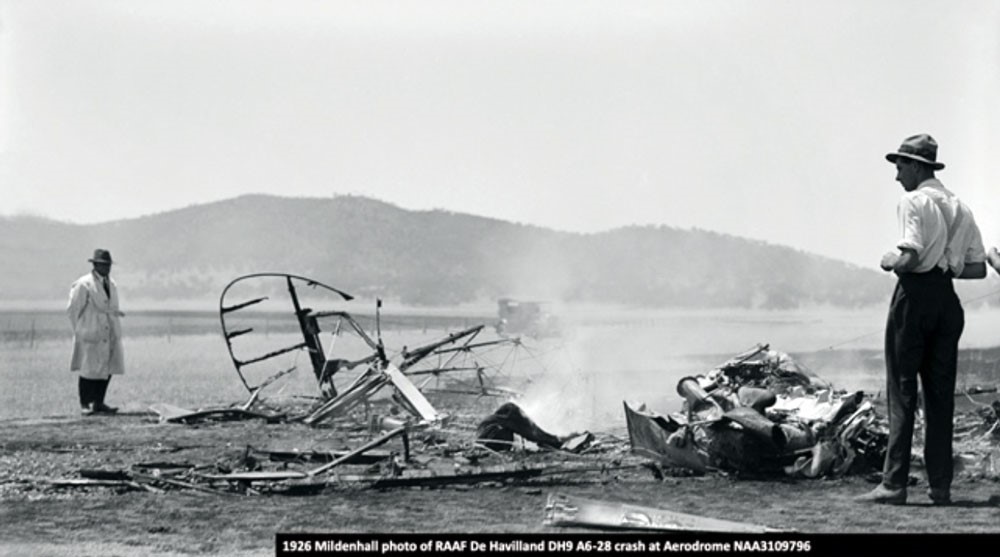
Local ploughman Walter Johnson was working nearby and immediately ran to the blazing wreckage and attempted to claw the men out with his bare hands. It was too late for Pitt, who was killed instantly and by the time Canberra Fire Brigade arrived and drowned the fire, Callander was too injured and died soon afterwards in hospital.
Pitt was buried in an unmarked grave in Queanbeyan and Callander, with his name misspelt, at St John’s in Reid. Johnson was awarded a national bravery award for his service.
Later that year, the aerodrome was closed because the Duke of York was coming for the opening of Parliament House and Dickson was tricky to approach from some angles due to Mount Ainslie. It reverted to a sheep paddock and eventually housing as suburban Canberra expanded but the stories are still kept alive by the Dickson Residents Group.
Historians still believe fragments of the crashed plane might be buried under Blacket Street in Downer. One of four concrete ‘lockspits’ that marked the corners of the airfield is visible in the wetlands near Dutton Street.

Galileo's Hypothesis.
Galileo, the father of physics, was born in Pisa, Italy, in 1564 and lived until 1642. He discovered the Moons of Jupiter, Io, Europa, Ganymede and Callisto and the Rings of Saturn, among other things. Galileo also hypothesised that all objects falling to Earth fall at the same rate. He mentioned that a cannonball and a feather, if dropped from the same height, will touch the ground at the same time provided there is no air resistance.
This was hard to believe and even Galileo had difficulty explaining it for quite a long time. Four centuries later, with the current technology, it has been experimentally demonstrated.
Watch the video below to view / listen to the verification experiment.
|
Asked my husband to put the pillowcases on the pillows. |
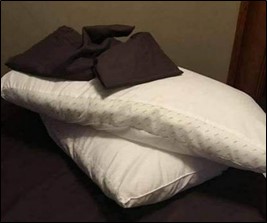 |
The Wedgetail.
The US Air Force (USAF) has selected the Boeing E-7A Wedgetail to become its next-generation airborne command and control aircraft. While this news may seem a world away to the average Australian, there is actually a direct link to the Royal Australian Air Force (RAAF), as the E-7A was originally developed in response to the RAAF’s ”Project Wedgetail” requirement for a new Airborne Early Warning and Control (AEW&C) aircraft.
The Wedgetail was the first of a new generation of large digital AEW&C aircraft and was designed from the ground up to meet Australia’s needs. Not long after Australia committed to the aircraft’s development, South Korea and Turkey also joined the program with four aircraft each, while the UK ordered five in 2018.
Because of its advanced design, the Wedgetail program was delayed by about three years. The first aircraft flew in 2002 and was to have been delivered by 2006, but integration issues with the radar and the aircraft’s sophisticated electronic warfare system saw that schedule slip a couple of times to 2009. The first two RAAF E-7As were built by Boeing in Seattle in the US, while the four others were converted from standard ”green” 737 airframes at Boeing Defence Australia’s facility at RAAF Amberley in Queensland.
The E-7A is based on a commercial Boeing 737-700 airframe, but features a large and distinct ”surfboard” radar on its rear fuselage as well as several other modifications. The radar is a fixed multi-mode electronically scanned array (MESA) unit that was developed by Northrop Grumman and, instead of spinning like conventional radar antennae, has thousands of individual transmit/review (T/R) nodes. Whereas conventional radars refreshed every few seconds as the antenna spins, the fixed MESA allows for continuous 360-degree monitoring of all parts of the airspace around the aircraft and can even divert power to specific parts of the antenna to electronically focus on, or ”stare”, at certain segments of airspace if required.
Rather than the 160 or so passenger seats a standard 737-700 airliner carries, the Wedgetail has about 10 side-facing consoles at which airborne radar and electronic warfare officers monitor the airspace and surface out to 300 km or beyond. The interior also has a large bank of computers, a galley and a crew rest area for long-endurance missions.
Externally, numerous antennae are added for communications, electronic self-protection, infrared self-protection and datalinks. The engines each have an additional generator so sufficient electrical power can be produced for the MESA and computers and an air-to-air refuelling receptacle has been added above the cockpit for long-endurance missions.

The RAAF has six E-7As in service with No 2 Squadron based at Williamtown.
The USAF currently flies about 20 ageing Boeing E-3G Sentry AWACS aircraft, which are based on the 1950s-era Boeing 707 airliner, the youngest of which was built in the early 1980s. Despite numerous electronic upgrades over the years, the E-3Gs are difficult and expensive to support as no commercial 707s remain in operation. Spare parts are therefore rare and the fleet has an availability rate of less than 60 per cent. They are also much larger and use four older-generation engines than the smaller and lighter twin-engined 737-based E-7A. By comparison, the 737 airliner is in widespread service worldwide and is still in production and spares are expected to be available for decades to come.
As the RAAF began to incorporate its six E-7As into service, it started deploying them on major overseas exercises with US and other allied forces and then in 2014 to the Middle East as an element of Australia’s Operation Okra commitment to the fight against ISIS. It was then that the US began to sit up and take notice of the capabilities offered by the E-7A and, after reports began filtering back from exercise partners and exchange officers, the US Congress took interest. In February 2023, the USAF awarded Boeing a $US1.2 billion ($A1.85bn) contract to begin development of its first two E-7As, with the first aircraft to be ready for operations in 2027 and an eventual requirement for 26 aircraft. USAF leadership has described the Wedgetail as a “proven capability”, one that can be developed and introduced into service relatively quickly compared with a ”clean-sheet” design.

Insulated Food Container.
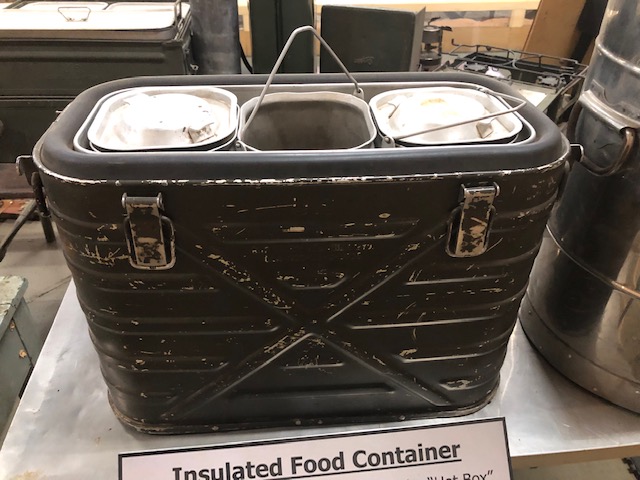
Remember these?
Seen at the Army museum at Bandiana, near Albury Wodonga, the “Hot Box” was Introduced into service in the 1960’s and was used to transport hot and cold meals to troops in the field. Insulated food containers were phased out of service during the late 1990’s.
There are only 2 items you need in your emergency tool kit
1. If it moves and shouldn't - duck tape.
2. If it doesn't move and should - WD40
Service station takeover: OTR expansion set to wipe out Coles Express
You might not be seeing this Shell sign around for too much longer. Viva Energy’s acquisition of a major South Australian service station chain gives consumers the first glimpse of what’s in store for Coles Express.
Viva Energy announced it will acquire OTR Group from Peregrine Corporation for $1.15 billion. This comes after Viva Energy, which already ran Shell-branded servos, bought Coles Express service stations for $300 million last year. At the time of the Coles Express acquisition, it was announced the 710 nationwide stores would be rebranded after the deal is completed.
The OTR sale gives a clearer picture of what that rebrand will look like.
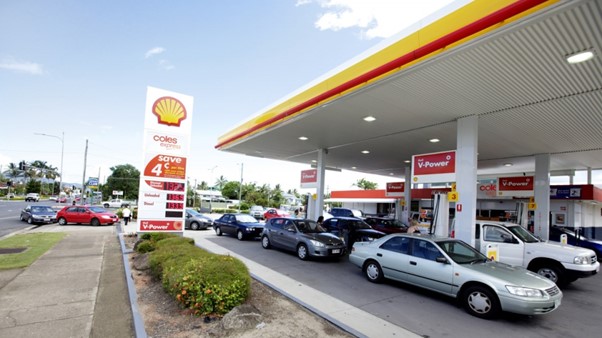
When Coles Group is no longer pulling the strings behind Coles Express stores following their transition to Viva Energy in this year’s second quarter, the latter will look to distance itself from the supermarket brand. A major part of that will be rebranding the stores. In a recent announcement, Scott Wyatt, Viva Energy CEO and managing director, said OTR will become the company’s flagship convenience brand and will replace the Coles Express brand over time.
It is understood only Coles Express stores with a ‘suitable footprint’ will be rebranded under the OTR banner; others will be rebranded under a yet-to-be-announced sub-brand. It is currently unclear if Coles will continue supplying products for its former Coles Express service stations following the rebrand, if not, it will be a significant departure from the precedent set by Woolworths, which continues to supply its products to Ampol and Caltex following the sale of its 540 fuel convenience sites to EG Group in 2019.
Focus shifts from fuel.
OTR is a major South Australian – and migrant – success story, which began in 1984 when Fathi (Fred) Shahin bought a single Adelaide petrol station after fleeing with his family from civil unrest in the Middle East. Today, the OTR Convenient Retail network comprises 205 stores under the OTR brand, including 174 integrated fuel and convenience stores and 31 stand-alone stores.
More than 90 of those stores incorporate quick service restaurants (QSRs) such as Hungry Jack’s, Subway and Guzman y Gomez, many of which include drive-throughs.
OTR also has a growth pipeline of 90 sites, largely outside of South Australia, which will be developed into new OTR stores over the next few years. This will aid Viva Energy’s goal to be Australia’s leading convenience retailer by establishing more than 1000 stores.
Viva Energy’s service stations will shift from fuel to retail. The move has a good basis; OTR generates more than $3 billion in annual revenue, with more than 70 per cent of earnings coming from non-fuel sources. As their stores increasingly become retail destinations, they expect convenience earnings will grow and reduce their dependency on traditional fuels.
After completing its acquisition of OTR, Viva Energy plans to acquire Liberty Convenience, according to the company’s recent ASX release.
Big changes coming in the fuel game.
For most people when you lose your khakis you’ve lost your pants.
When you’re from NZ and lose your khakis you can’t start your car.
|
Balancing the dots…
When you look at a brand new tyre, you may have seen a little red or yellow dot on the sidewall. Most people probably just assume it’s an ink mark applied for some internal tyre company reason. Actually, those dots are extremely helpful when you are fitting a brand new set of tyres. The dot is applied to the lightest part of the new tyre.
When fitting a new tyre, they normally align this dot with the valve stem and/or tyre pressure monitor. By doing this, it makes balancing the tyre far easier and you can apply fewer wheel weights to offset the balance. |
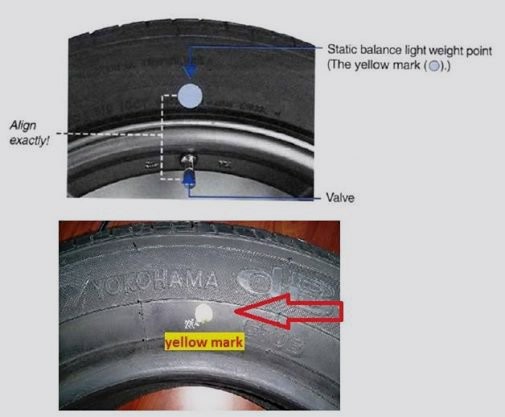 |
I was asked what I look for in a relationship, apparently “A way out” wasn’t the right answer.
A Field Guide to WD-40
There’s a lot more to lubrication than a shot from a spray can that you keep in the kitchen drawer.
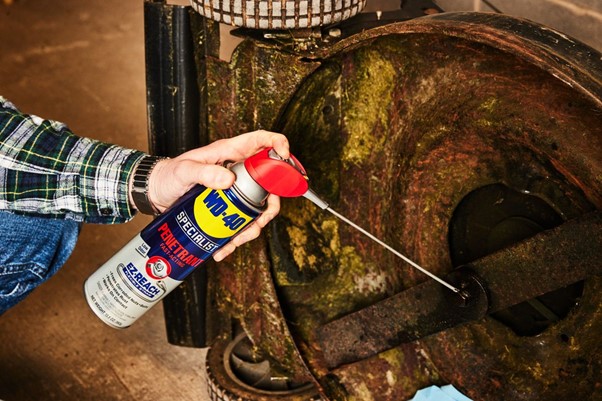
WD-40. For many people, the name means lubrication. A hinge squeaks or a bolt sticks in its hole, you give it a shot from the familiar spray can. The lubricant is as close to ubiquitous as these materials can be. All over this country, it’s stashed in kitchen drawers, car boots, on garage shelves, in tool boxes, on workbenches and in maintenance carts on factory floors. It’s sold nearly everywhere: hardware stores, farm-supply stores and in supermarkets.
We have nothing more than anecdotal evidence to make this claim, but aside from engine oil, it may be the most widely used lubricant. The company states something like 2,000 uses for its flagship spray, everything from silencing squeaky hinges to freeing a python wrapped around the undercarriage of a bus. Police even used it once to grease down a naked burglar who got stuck as he squirmed his way into a building via an air conditioning duct.
This is the WD-40 which its label identifies simply as “Multi-use Product.” Not oil. Not corrosion inhibitor. Not penetrant. Below that disarmingly simple title, the can text reads, “stops squeaks, removes and protects, loosens rusted parts, frees sticky mechanisms, drives out moisture.”
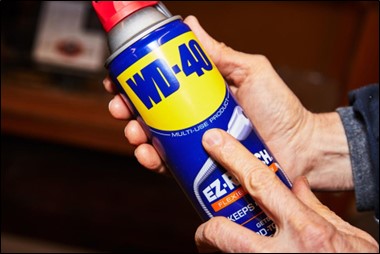
The most well known version of WD-40 is the flagship product that launched the company. Now simply called “ Multi-Use Product”, it’s good for basic lubricating, cleaning and rust protection. It’s not suited for many other jobs, such as chain lubrication, where it can actually remove the specialized lubricant used on chains.
As good as WD-40 is, it can't do everything. No lubricant can. That is the basis of this story. There’s a lot more to lubrication than a shot from a spray can that you keep in the kitchen cabinet. Aside from the most familiar form of WD-40, there are a lot of other products that excel at specific jobs and there are many variations of WD-40 other than the ubiquitous multi-use version.
A History Lesson.
WD-40 Multi-Use Product is the familiar go-to spray. It’s flanked by the variations formulated for difficult lubrication jobs, such as lubricating roller chain, a formulation that ejects as a liquid but converts to a gel to cling to vertical surfaces and fast-moving parts. Other products, such as contact cleaner is safe to use on electrical components while the silicone formulation is intended to lubricate and protect plastics and rubber. Here, the complexities of lubrication are reduced to simplicity: read the can to get a sense of what the product is good for.
The now iconic brand takes its name from its formulation. WD-40 stands for Water-Displacement 40, a thin-film lubricant that displaces moisture and was perfected on the 40th attempt. Three employees of the Rocket Chemical Company in San Diego formulated the blend in 1953 and it soon found large scale commercial success as a corrosion protection coating applied to the skin of Atlas missiles.
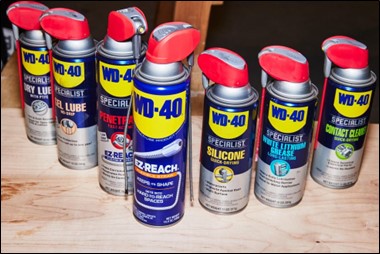
The flagship formulation is a blend of high-quality, light-body lubricating oils propelled out of the can with CO2. The company added a light fragrance in 1961 and that's about as close as it ever came to doing anything strange with it. Its formulation is so closely guarded that it was never patented and the MSDS that describes it is barely helpful for identifying the contents in the can. The company stores the formula not in its headquarters in San Diego, but in a bank vault nearby.
A long list of commercial successes followed those humble beginnings, leading the company to where it is today, a publicly-traded entity with stock trading in the vicinity of $171.50 per share. It’s a small but commercially important cog in the lubrication industry, a market worth nearly $19 billion annually.
That gigantic lubrication market and the brand’s strong acceptance among users, explains why the company makes more than its most familiar lubricant. Its catalogue lists 22 products each available in a range of sizes and applicator types. In all, these various formulations encompass general spray lubricant, industrial grease, bike chain lube, roller chain lubrication, rust removers and a variety of cleaners. It’s all related: cleaning, lubrication and corrosion protection.
Understanding Lubrication
Lubrication is notoriously complicated. Parts in motion relative to one another make physical contact causing sharp microscopic pieces of material to be broken off. These jagged particles tumble around, further increasing the friction between the parts, increasing heat and accelerating surface damage. In turn, this causes more particles to break free and the damage cycle repeats itself and is magnified until one or both parts fail. Lost in history, people discovered that placing tallow or wax between the parts helped them interact with less damage.
It seems that early on in WD-40’s history people understood one thing about it: It’s easy. Something needs lubrication? Grab the spray can and hose it down. What’s more, it’s even pleasant. It doesn’t stink. Nothing smells offensive when you’re done. Not you. Not the part. Plus, it’s easy to find. The can’s graphics make it jump out in a cluttered workshop. And, it’s easy to buy. When the can runs out, pick up another one at the grocery store–or seemingly at any store.
Maybe it’s a little too easy, leading people to use the standard product when they should be using something else. Therein lies a problem.
Lubrication is a highly specific business. While the WD-40 Multi-Use Product is viewed as a ‘one-can wonder’ it does have specialized needs for specific pain points. To do the job properly there are three things you should know:
Start with a clean surface
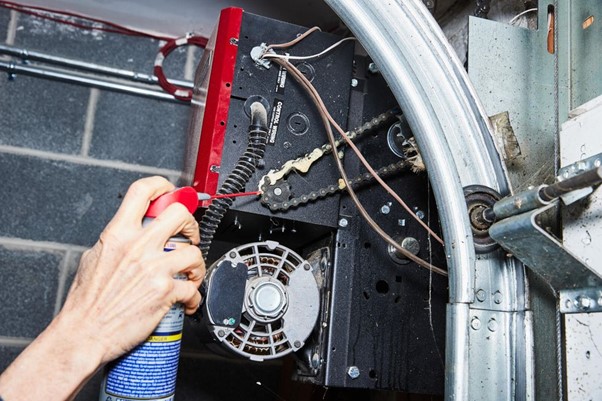
It can be tempting to pull out a spray can and get to work but cleaning a surface before lubricating is important because contaminants can degrade lubrication, making it less effective. Dirt, rust and particles of loose paint are all abrasive substances. If you want lubrication to perform at an optimal level, you need to remove these. Clean first, then lubricate.
Surface type matters:
A multi-purpose lubricant works well on metal surfaces but materials such as plastics and rubber require special lubricants with compatible additives.
Specifications are important
Everyone loves the idea of a ‘one-can wonder’ but not all lubricants are the same. Select the lubricant based on the surface material, the kind of load you expect the lubricant to see, temperature, humidity and even the position of the parts in service, such as whether the lubricant will be applied on vertical surfaces, horizontal surfaces, or whether the lubricant will have to cling to the bottom of a horizontal surface. All of this matters.
Lubrication Additives
Most lubricants consist of a base oil and additives that improve its performance. Perhaps no other aspect of lubrication is as tricky as selecting a lubricant based on these additives. People shopping for lubrication will notice the addition of silicone, PTFE (Poly Tetra Fluoro Ethylene; Teflon is one form of this), molybdenum disulphide and molybdenum diakyl dithio carbamate (either of them are simply called “moly”), copper, white lithium, zinc and graphite. Additives play any number of roles in a lubricant, they can thicken it so it clings to vertical surfaces while helping it withstand exposure to the elements (white lithium). Other additives, such as silicone, lubricate plastics and rubber while not dissolving them. The addition of “moly” helps to lubricate metal-to-metal surfaces where there is extreme pressure and heat. The addition of copper to a lubricant helps threaded parts turn freely while resisting galling, a phenomenon where metal particles are broken loose only to reattach themselves to an adjacent surface in a process known as cold welding.
White lithium is an additive to grease, lubricating oils and (in this case) specialized spray lubricants. The material thickens the lubricant, helping it stay in place and acts as an agent to hold and release lubricant as needed. It’s a heavy-duty product used in exterior and interior metal-to-metal applications, such as on a garage door cable.
Some of these additives are solids that interact physically with the surface, other additives are chemicals. A good way to think of solid additives is that they are like molecular ball bearings, or in some cases platelets, that contribute to the free movement of parts relative to one another. Chemical additives may improve the lubricant’s performance in other ways, such as helping to fight corrosion or increasing fire resistance.
As a group, lubricating oils that contain additives are considered “high performance” relative to lubricants that lack them. Sure, you may pay more for these formulations, but the performance benefits they provide are worth it.

Velly Intelesting - but stoopid!!
Back Go to page: 1 2 3 4 5 6 7 8 9 10 11 12 13 14 15 16 17 18 19 20 Forward